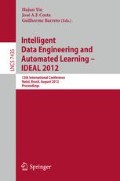Abstract
During the rehabilitation process, individuals who have experienced a total or partial loss of upper limbs are exposed to many risks. Besides this, a great mental effort is required during the training phase to adapt to a real prosthesis. In many cases, the use of Virtual Reality in Medicine has proven to be an excellent tool for evaluation and support as well as to mitigate risk and to reduce mental effort required. In order to be useful, virtual prosthesis must have a great similarity with the real world. For this reason, artificial neural networks have been explored to be applied in the training phase to provide real time response. The objective of this study is to compare the performance of the LVQ and MLP neural networks in EMG (muscle activity) pattern recognition. To achieve this, different feature extraction techniques for simulation and control of virtual prostheses are investigated.
Access this chapter
Tax calculation will be finalised at checkout
Purchases are for personal use only
Preview
Unable to display preview. Download preview PDF.
References
Nishikawa, D., Yu, W., Yokoi, H., Kakazu, Y.: On-Line Learning Method for EMG Prosthetic Hand Control. Electronics and Communications in Japan, 1510–1519 (2001)
Fausett, L. (ed.): Fundamentals of neural networks: architectures, algorithms, and applications. Prentice-Hall, Inc., Upper Saddle River (1994)
Herle, S., Raica, P., Lazea, G., Robotin, R., Marcu, C., Tamas, L.: Classification of surface electromyographic signals for control of upper limb virtual prosthesis using time-domain features. In: Proceedings of the 2008 IEEE International Conference on Automation, Quality and Testing, Robotics, pp. 160–165 (2008)
Sebelius, F., Axelsson, M., Danielsen, N., Schouenborg, J., Laurell, T.: Real-time control of a virtual hand. Technology and Disability 17(3), 131–141 (2005)
Huang, H., Liu, Y., Liu, L., Wong, C.: Emg classification for prehensile postures using cascaded architecture of neural networks with self-organizing maps. In: Proceedings of IEEE International Conference on Robotics and Automation, ICRA 2003, vol. 1, pp. 1497–1502. IEEE (2003)
Pons, J., Ceres, R., Rocon, E., Levin, S., Markovitz, I., Saro, B., Reynaerts, D., Van Moorleghem, W., Bueno, L.: Virtual reality training and EMG control of the MANUS hand prosthesis. Robotica 23(03), 311–317 (2005)
Nogueira, K.L.: O Uso de Técnicas de Realidade Virtual e Aumentada na Simulação de Prótese de Membros Superiores. Master’s thesis, Universidade Federal de Uberlndia, Uberlndia (Julho 2007)
Soares, A., Andrade, A., Lamounier, E., Carrijo, R.: The development of a virtual myoelectric prosthesis controlled by an EMG pattern recognition system based on neural networks. Journal of Intelligent Information Systems 21(2), 127–141 (2003)
Mattioli, F., et al.: Utilização de redes neurais para a classificação de sinais emg aplicados no controle de próteses virtuais de mão. In: Proceedings of the WRVA 2010, pp. 230–235 (2010)
Peretta, I.: A novel Word Boundary Detector based on the Teager Energy Operator for Automatic Speech Recognition. PhD thesis, Master’s Thesis, Federal University of Uberlândia, UFU (2010)
Mattioli, F., Lamounier, E., Cardoso, A., Soares, A., Andrade, A.: Classification of emg signals using artificial neural networks for virtual hand prosthesis control. In: 2011 Annual International Conference of the IEEE Engineering in Medicine and Biology Society, EMBC, pp. 7254–7257. IEEE (2011)
Hudgins, B., Parker, P., Scott, R.N.: A new strategy for multifunction myoelectric control. IEEE Transactions on Biomedical Engineering 40(1), 82–94 (1993)
Lamounier, E.A., Lopes, K., Soares, A.B.: Using augmented reality techniques to simulate myoelectric upper limb prostheses. Bioengineering & Biomedical Science, S1:010 (2012), doi:10.4172/2155-9538.S1-010
Machover, C., Tice, S.: Virtual reality. IEEE Computer Graphics and Applications 14(1), 15–16 (1994)
Author information
Authors and Affiliations
Editor information
Editors and Affiliations
Rights and permissions
Copyright information
© 2012 Springer-Verlag Berlin Heidelberg
About this paper
Cite this paper
Caetano, D., Mattioli, F., Nogueira, K., Lamounier, E., Cardoso, A. (2012). Comparison between MLP and LVQ Neural Networks for Virtual Upper Limb Prosthesis Control. In: Yin, H., Costa, J.A.F., Barreto, G. (eds) Intelligent Data Engineering and Automated Learning - IDEAL 2012. IDEAL 2012. Lecture Notes in Computer Science, vol 7435. Springer, Berlin, Heidelberg. https://doi.org/10.1007/978-3-642-32639-4_47
Download citation
DOI: https://doi.org/10.1007/978-3-642-32639-4_47
Publisher Name: Springer, Berlin, Heidelberg
Print ISBN: 978-3-642-32638-7
Online ISBN: 978-3-642-32639-4
eBook Packages: Computer ScienceComputer Science (R0)

